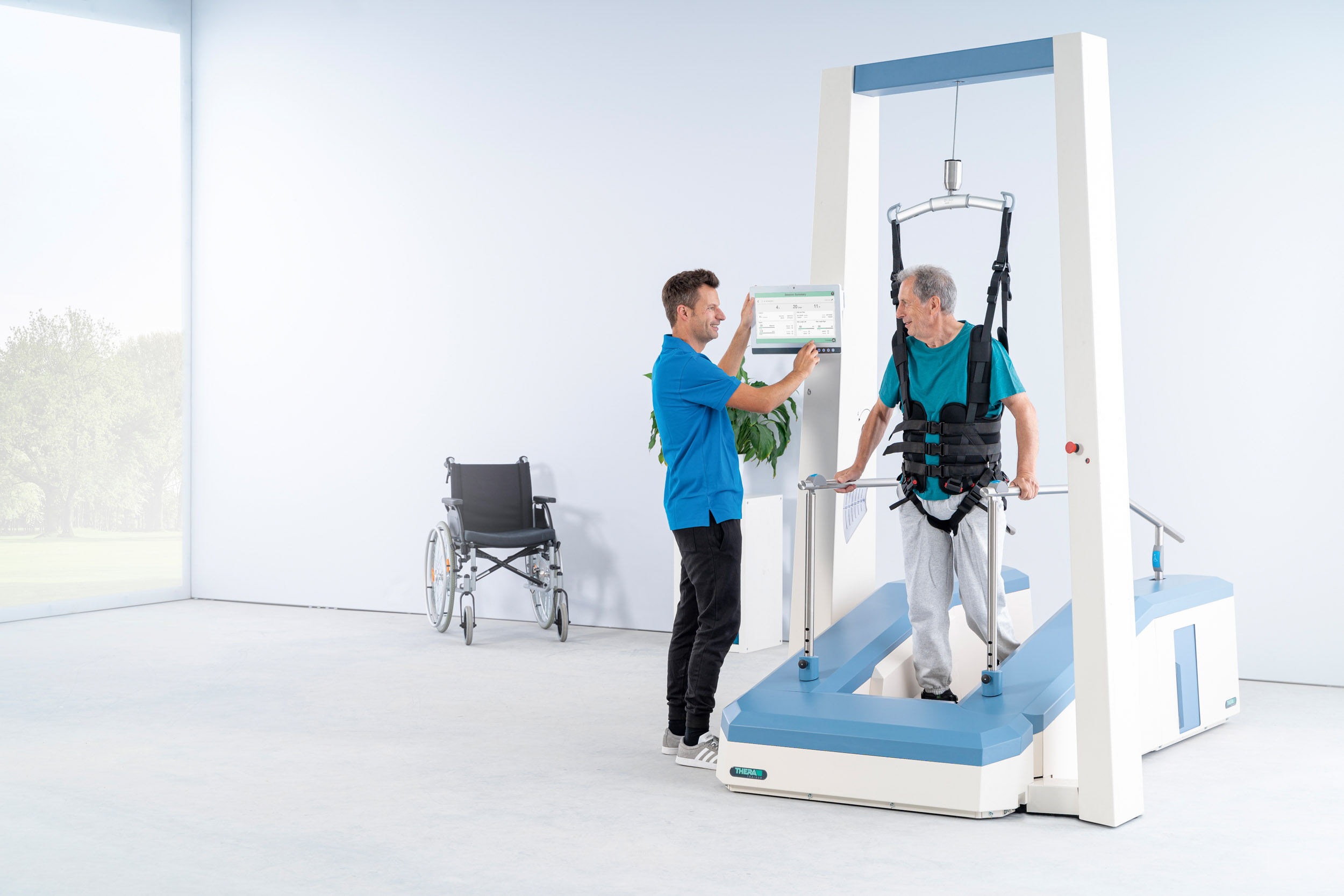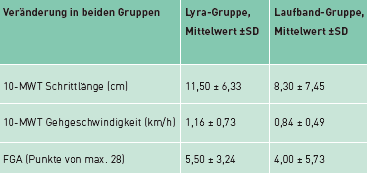
THERAPY-Magazin
Robot-assisted gait training for Parkinson’s disease

Veronika Seidl
Physiotherapy,
Neurologisches Therapiezentrum
Gmundnerberg, Altmünster, Austria
Robot-assisted gait training using the THERA-Trainer lyra with end‑effector guided steps vs. treadmill training with visual step guidelines in patients with Parkinson’s disease:
Parkinson’s disease is one of the most common neurodegenerative diseases worldwide [1]. Some of the symptoms, such as balance and gait disturbances and risk of falls, respond poorly to pharmacotherapy [2]. Therefore, physiotherapy is an important component in the treatment of patients with Parkinson’s disease [3]. With robotic gait training or treadmill training, it is possible for patients to increase walking distance and step repetitions during therapy [4]. This is important for motor learning and improving walking skills in everyday life.
The aim of this study was to investigate whether robotic gait training using the THERA-Trainer lyra with end-effector guided steps can improve stride length more than treadmill training with visually prescribed steps.
In this randomised controlled trial, 20 patients with Parkinson’s disease (Hoehn & Yahr 1-4) were randomly assigned to 2 groups: a THERA-Trainer lyra group and a treadmill group. Each group received 30 minutes of gait training 3 days per week for 4 weeks. Patients were assessed by a physiotherapist before the procedure, after each treatment and at the end of the procedure. The primary outcome parameter was stride length, measured with the 10-metre walk test.
At the beginning of the study, there were no differences between the two groups. After four weeks, both groups had improved their stride length in the primary target value (THERA-Trainer lyra - Group A: mean value 11.50 cm ± 6.33; Treadmill - Group B: mean value 8.30 cm ± 7.45), but no significant differences were found between the two groups (p = 0.58).
The aim of this study was to investigate whether robotic gait training using the THERA-Trainer lyra with end-effector guided steps can improve stride length more than treadmill training with visually prescribed steps.
In this randomised controlled trial, 20 patients with Parkinson’s disease (Hoehn & Yahr 1-4) were randomly assigned to 2 groups: a THERA-Trainer lyra group and a treadmill group. Each group received 30 minutes of gait training 3 days per week for 4 weeks. Patients were assessed by a physiotherapist before the procedure, after each treatment and at the end of the procedure. The primary outcome parameter was stride length, measured with the 10-metre walk test.
At the beginning of the study, there were no differences between the two groups. After four weeks, both groups had improved their stride length in the primary target value (THERA-Trainer lyra - Group A: mean value 11.50 cm ± 6.33; Treadmill - Group B: mean value 8.30 cm ± 7.45), but no significant differences were found between the two groups (p = 0.58).
The aim of this study was to investigate whether robotic gait training using the THERA-Trainer lyra with end-effector guided steps can improve stride length more than treadmill training with visually prescribed steps.
Secondary outcome measures were walking speed and postural stability during walking, which also improved in both groups without significant difference. The results show a trend towards improvement in gait abilities through training with the THERA-Trainer lyra, but larger studies are needed to further investigate the effectiveness of robotic gait training with the THERA-Trainer lyra in patients with Parkinson’s disease.

Ambulante Rehabilitation
Fachkreise
Gait
lyra
Science
Stationäre Rehabilitation
THERAPY 2023-II
THERAPY Magazine

Veronika Seidl
Physiotherapy,
Neurologisches Therapiezentrum
Gmundnerberg, Altmünster, Austria
Veronika Seidl Physiotherapy,
Neurologisches Therapiezentrum
Gmundnerberg, Altmünster, Austria
References:
- GBD 2016 Parkinson’s Disease Collaborators, 2018
- Ceballos-Baumann & Ebersbach, 2018
- Keus et al., 2014
Related contents
Find related exciting contents in our media library.
This is not what you are searching for? Knowledge
Meet our specialists.
Are you interested in our solutions? Schedule a meeting with a Consultant to talk through your strategy and understand how TEHRA-Trainer can help you to advance rehabilitation.
You need to load content from reCAPTCHA to submit the form. Please note that doing so will share data with third-party providers.
More InformationYou are currently viewing a placeholder content from Turnstile. To access the actual content, click the button below. Please note that doing so will share data with third-party providers.
More Information